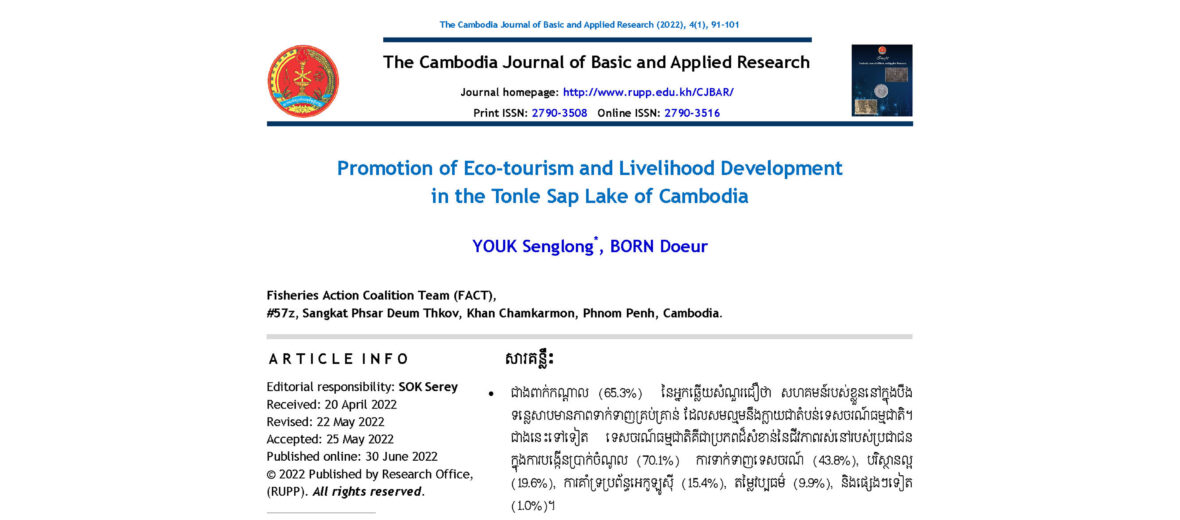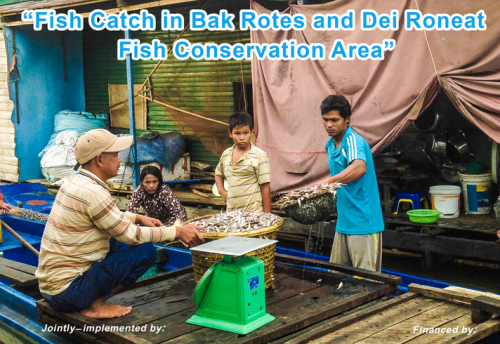
សារគន្លឹះ
- ជាងពាក់កណ្តាល (65.3%) នៃអ្នកឆ្លើយសំណួរជឿថា សហគមន៍របស់ខ្លួននៅក្នុងបឹងទន្លេសាបមានភាពទាក់ទាញគ្រប់គ្រាន់ ដែលសមល្មមនឹងក្លាយជាតំបន់ទេសចរណ៍ធម្មជាតិ។ជាងនេះទៅទៀត ទេសចរណ៍ធម្មជាតិគឺជាប្រភពដ៏សំខាន់នៃជីវភាពរស់នៅរបស់ប្រជាជនក្នុងការបង្កើនប្រាក់ចំណូល 70.1%) ការទាក់ទាញទេសចរណ៍ (43.8%), បរិស្ថានល្អ (19.6%), ការគាំទ្រប្រព័ន្ធអេកូឡូស៊ី (15.4%), តម្លៃវប្បធម៌ (9.9%), និងផ្សេងៗទៀត (1.0%)។
- ខេត្តសៀមរាបមានសក្តានុពលខ្ពស់ជាងគេក្នុងវិស័យទេសចរណ៍ធម្មជាតិនេះដោយសារវិស័យនេះមានសេវាកម្មមួយចំនួនរួចស្រាប់ទៅហើយ ដូចជាការជួលទូក (4%), ការលក់អាហារ (4.3%), និងមគ្គុទ្ទេសក៍ទេសចរណ៍ (3.6%) ជាដើម។ នៅខេត្តបាត់ដំបង 1.6% នៃអ្នកឆ្លើយសម្ភាសន៍អាចរកចំណូលបានពីការជួលទូកជូនភ្ញៀវទេសចរណ៍ និងប្រមាណ 1.1% អាចរកចំណូលបានពីការផ្តល់សេវាមគ្គុទ្ទេសក៍ទេសចរណ៍។
- ជាទូទៅ អ្នកឆ្លើយសំណួររកកម្រៃបានជាមធ្យម 6 ដុល្លារក្នុងមួយខែ។ អ្នកឆ្លើយសំណួរនៅខេត្តសៀមរាបអាចរកចំណូលបានពីទេសចរណ៍ធម្មជាតិ ជាមធ្យម 721.4 ដុល្លារក្នុងមួយខែ ចំណែកអ្នកឆ្លើយសម្ភាសន៍នៅខេត្តបាត់ដំបង និងបន្ទាយមានជ័យស្ទើរតែមិនមានប្រាក់ចំណូលពីសេវាកម្មទេសចរណ៍ធម្មជាតិទេ។ ពួកគេបានបណ្តាក់ទុន 78.2 ដុល្លារ ដែលក្នុងនោះ ដើមទុនផ្ទាល់ខ្លួន 76.2 ដុល្លារ ទៅលើការផ្តល់សេវាទេសចរណ៍ធម្មជាតិ។
- អង្គការមិនមែនរដ្ឋាភិបាល (NGOs) បានដើរតួនាទីយ៉ាងសំខាន់ក្នុងការកសាងសមត្ថភាព និងក្នុងការផ្ដល់ការគាំទ្រផ្នែកបច្ចេកទេសតាមរយៈការបណ្តុះបណ្តាល និងការគាំទ្រជាប្រចាំដើម្បីដំណើរការសវាកម្មទេសចរណ៍ធម្មជាតិនេះ អ្នកចូលរួមឆ្លើយសំណួរបានទទួលការបណ្តុះបណ្តាលពីអង្គការមិនមែនរដ្ឋាភិបាល (0%), ពីមិត្តភ័ក្ត (4.3%), និងពីស្ថាប័នរដ្ឋ (2.9%)។
- ទេសចរណ៍ធម្មជាតិគួរតែត្រូវបានលើកកម្ពស់តាមរយៈការកែលម្អហេដ្ឋារចនាសម្ព័ន្ធរូបវន្ត និងការកសាងជំនាញក្នុងវិស័យទេសចរណ៍និងបដិសណ្ឋារកិច្ច។ ដើម្បីបង្កើនការយល់ដឹង និងការគាំទ្រជាសាធារណៈ បណ្ដាញទេសចរណ៍ធម្មជាតិបឹងទន្លេសាបគួរតត្រូវបានបង្កើតឡើងដើម្បីឱ្យអ្នកពាក់ព័ន្ធទាំងអស់ អាចចូលរួមបង្កើនសេវាកម្មទេសចរណ៍ធម្មជាតិ តាមរយៈការធ្វើវិនិយោគ និងការធ្វើទីផ្សារ។ ការវិនិយោគរបស់វិស័យឯកជន គួរតែត្រូវបានទទួលស្គាល់ថាមានសារសំខាន់ខ្លាំងណាស់ក្នុងការកែលម្អហេដ្ឋារចនាសម្ព័ន្ធរូបវន្តនិងការធ្វើឱ្យសេវាកម្មមានភាពសម្បូរបែប។ ជាងនេះទៅទៀត អាជ្ញាធរមូលដ្ឋានគួរពិចារណាក្នុងការបែងចែកថវិកាមូលនិធិឃុំចន្លោះពី 5% ទៅ 10% ដើម្បីបង្កើនជីវភាពក្នុងវិស័យទេសចរណ៍ធម្មជាតិ។
Key Messages
• More than half of the respondent (65.3%) believe that their communities in the Tonle Sap Lake are attractive enough to be eco-tourism sites. Moreover, eco-tourism is an important source of people’s livelihood in terms of income generation (70.1%), tourist attraction (43.8%), good environment (19.6%), ecosystem support (15.4%), cultural value (9.9%), and other (1.0%).
• Siem Reap has higher potential for this sector; respondents indicated they already provided some services such as boat rentals (6.4%), selling meals (4.3%), and tourism guide (3.6%). In Battambang, services provided included boat rentals (1.6%), and tour guides (1.1%).
• On average, the respondents earned 159.6 US$ per month, while the respondents in Siem Reap earned an average of 721.4 US$ per month from eco-tourism, there was little income generated from eco-tourism in Battambang and Banteay Meanchey provinces. They invested 78.2 US$ with 76.2 US$ from their own capital to eco-tourisms service provision.
• Non-governmental organization (NGOs) have played very important role in building capacity and providing technical support through training and daily support to operate eco-tourism services. The respondents received training from NGOs (5.0%), friends/relatives (4.3%), and government agencies (2.9%).
• Ecotourism should be promoted through improved physical infrastructure and skill-building in tourism and hospitality. To increase public awareness and support, the Tonle Sap Eco-Tourism Network should be established to connect all the stakeholders to enhance eco-tourism services through investment and marketing. Moreover, private sector investment should be recognized as important to improve physical infrastructure, and services diversification. The local government should consider allocating 5-10% of the communal budget to the development of livelihoods in the area of eco-tourism.
សម្រាប់ព័ត៌មានលម្អិតសូមចុចចូលទៅកាន់ដំណរភា្ចប់ខាងក្រោម៖
Link Document: https://drive.google.com/drive/folders/1iOzXZdbRtP2DCNQ3tRZN8x6tXpNzuFuc?usp=share_link















Leave a Reply